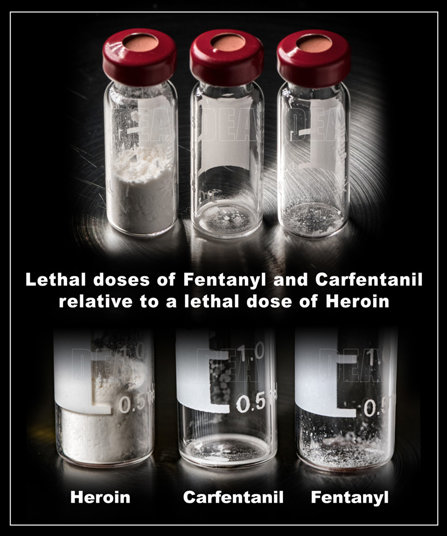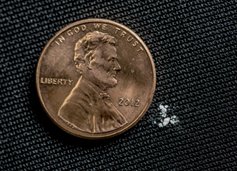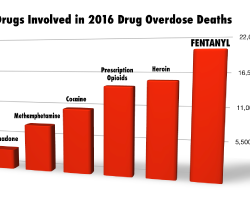The Difference between Fentanyl and Other Opioids—Why So Many Addicts Die

If you’ve had your eye on health news, you’ve probably heard “fentanyl” mentioned more than once in the last year. And why is that? Fentanyl is a powerful and potent opioid pain reliever first introduced into the medical pain-relief sector for treating cancer patients. Now it is one of the most potent and lethal drugs used in the United States and it kills thousands of Americans every year.
A cursory study of CDC and NIDA data (more on that later) will reveal that fentanyl alone claims more lives than any other drug in the U.S. And most opiate overdoses are now attributable to fentanyl. What makes this drug different? Why are so many addicts dying from just one drug? How did this get so out of hand?
All About Fentanyl

Fentanyl is single-handedly changing the landscape of the American opioid epidemic. Fentanyl was first brought onto the medical scene in the late 1990s. The goal was to offer this drug to cancer patients who struggled with “breakthrough pain.”
Breakthrough pain is a particular type of pain condition where the patient experiences random and unpredictable surges in pain that are in addition to the chronic pain levels that they already suffer. The breakthrough pain overwhelms the pain-relief effects of whatever current pain medication the patient is on. This problem is quite common with cancer patients, and so fentanyl was brought to the table as an intermediary drug to help cancer patients when they were struggling with breakthrough pain.
However, when not taken exactly as prescribed (and sometimes even when taken as prescribed), fentanyl use can have a euphoric, mind-altering effect on the user. Fentanyl (much like heroin, morphine, and other opioids) binds to the body’s opioid receptors. Such receptors control pain and emotion. Thus bound, fentanyl increases dopamine levels in the brain’s reward centers. Which in turn produces a powerful state of euphoria and relaxation in the user.
But here’s where the drug becomes truly harmful. When fentanyl binds to opioid receptors, the drug binds to all opioid receptors, including the receptors which control breathing and heart rate. Fentanyl (and other opioids) act to slow down bodily function. That is part of why the “high” felt in opioid use is such a dull, relaxed, slowed, dazed sort of feeling. The result of this full-body slowing effect is that the body begins to shut down. Breathing slows. Heart rate drops. An opioid overdose is just the complete slowing of breathing and heart rate until the user stops breathing and their heart stops beating altogether. Death follows shortly after.
But all of this is true for all opioids. This is not just how fentanyl operates. All opiates pose this risk. So why then does fentanyl claim so many more lives than any other opioid drug? What makes fentanyl so different?
Fentanyl—The Killer

The primary difference between fentanyl and other opioids (such as heroin) comes down to the potency. It’s merely a difference in their basic chemical structure. Both are opiates, but one is a hyper-concentrated opiate. A good analogy for comparing heroin to fentanyl would be comparing gunpowder to dynamite. They are certainly similar in structure, nature, and function, but gunpowder launches a bullet whereas dynamite explodes a mountainside. Similar, yes, but still very, very different.
An excellent pictorial representation of the core difference between heroin and fentanyl can be found in Column Health. Not only does that website have a good article on fentanyl, but they have a picture which compares quantities of how much heroin is needed to create a lethal dose and how much fentanyl is required to create a deadly dose. The disparity in amounts is striking.
According to the Drug Enforcement Administration, 2 milligrams of fentanyl is enough to kill most people. (Check out the DEA slideshow of photos that shows the disparity in lethal doses of fentanyl and heroin). For fentanyl, the lethal dose is an amount so small you could fit the entire dose on the tip of your finger. As for heroin, it’s a little tricky. Heroin comes in varying degrees of purity, but it usually takes about 75 to 100 milligrams of heroin to kill most people. The difference in lethal dosages from fentanyl to heroin is quite significant.
Both heroin and fentanyl bind to the opioid receptors in the brain and exert their function from there. The same is true of other opioid analgesics as well. But because of slight differences in fentanyl’s chemical makeup, this drug is assimilated into the bloodstream much faster and arrives at the opioid receptors of the brain long before heroin chemicals would.
Furthermore, fentanyl has a far more pronounced influence on opioid receptors than other opioids do. The drug clamps down on opioid receptors and controls them more harshly. It’s the difference between a gentle handshake and a knuckle-crushing, brutal handshake.

All of this leads to the fact that a much smaller dosage of fentanyl is needed to have the same lethality as heroin or other opioids. And when drug users hear that there is a “new” opiate on the market that can create “highs like never before” they tend to gravitate towards it.
But the problem is, no one ever believes just how little an amount of fentanyl it takes to be lethal. They always overestimate. And such an overestimation is even encouraged. Addicts want a potent product to experience a stronger high. Drug dealers want a strong product to sell to addicts to keep them coming back for more. Both sides of the drug-use culture will always lean on the overestimation side when divvying out quantities of drugs to use.
And what’s more, neither addicts nor dealers usually have any clue as to how to divvy out fentanyl without divvying out lethal doses. The result? Tens of thousands of fentanyl-related deaths since the turn of the century. From 2015 to 2016, overdose deaths attributable to fentanyl more than doubled, according to the Centers for Disease Control and Prevention.
According to the National Institute on Drug Abuse, fentanyl use accounted for 59 percent of all drug overdose deaths in 2017, the year we have with the most recent data. But in 2010, the drug only accounted for 14 percent of overdose deaths. This substance is becoming more common and it’s leaving a path of gravestones and broken families in its wake.
Breaking Free from a Fentanyl Habit
If you or someone you love is struggling with a fentanyl habit, getting help from a residential addiction treatment center is of the utmost importance. Time is of the essence with a fentanyl habit. This drug can go from recreational to lethal overnight.
Not sure if your loved one is hooked on fentanyl as opposed to something else? Learn the specific signs and symptoms of fentanyl misuse from the article here. Need to learn more about fentanyl in general? We have more resources on this drug to help educate you. We’re trying to inform as many people as possible about fentanyl. It is currently the greatest threat to human life on the U.S. drug scene. We all have to work together to curb this devastating problem, or it’s just going to keep taking more lives.
Sources:
- https://www.narconon.org/drug-abuse/fentanyl-effects.html
- https://columnhealth.com/blog_posts/why-is-fentanyl-so-dangerous/
- https://www.cdc.gov/mmwr/volumes/wr/mm6712a1.htm
- https://www.drugabuse.gov/publications/drugfacts/fentanyl
- https://www.narconon.org/drug-abuse/fentanyl-signs-symptoms.html
- https://www.narconon.org/drug-information/fentanyl.html


 ®
®